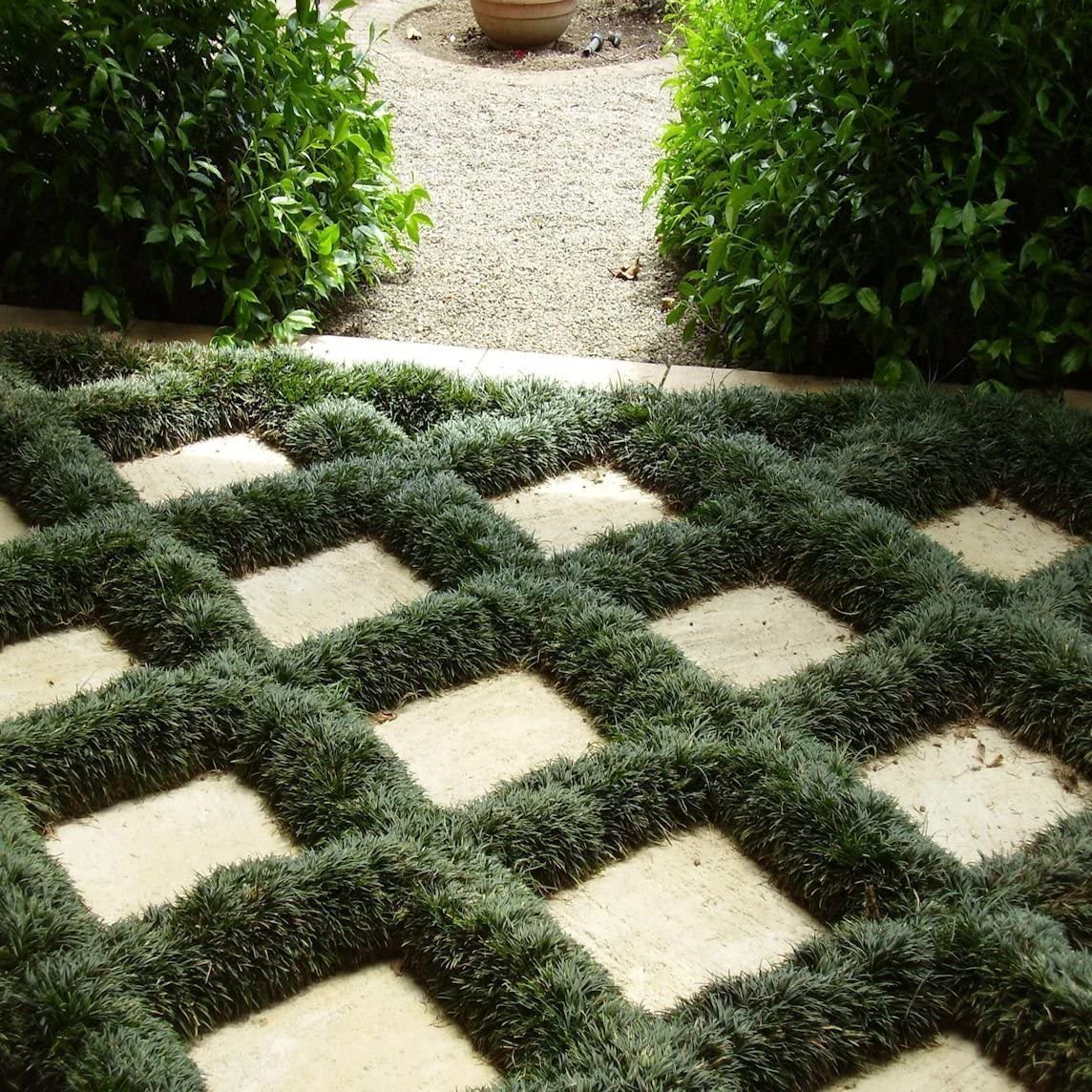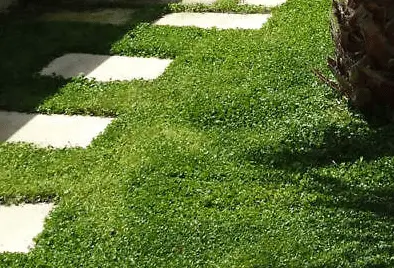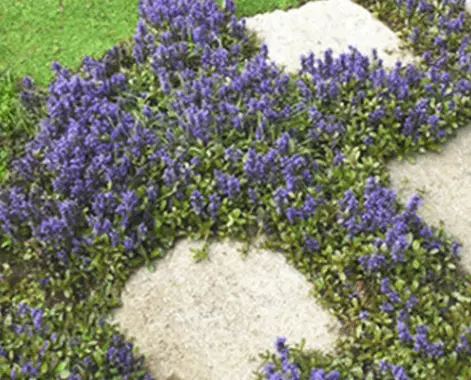Greenery between pavers or stepping stones can create a natural charming appearance of your patio or landscape. Lawn grasses or ground cover plants can be grown between the pavers or flagstones to achieve to upgrade the looks of your hardscapes as well as prevent weeds from taking over the spaces.
Ground cover plants are commonly used for outdoor décor and for weeds control in gardens and landscapes. However, few types of these plants can thrive under harsh outdoor conditions including traffic, limited spaces and extreme temperature variations.
For grass between pavers to grow successfully, you need to prepare the your beds with a well draining soil with a balanced pH and proper watering. It is also important to choose a type of grass or ground cover plants that will thrive well in your area climate conditions. And to add a touch of elegance you need to take good care of the greenery.
5 Best Ground Cover Plants
Here are best ground cover plants to prevent weeds between pavers or stones:
1. Irish Moss

Also known as Corsican pearlwort or Scot’s moss, the green moss like plants form a dense carpet of foliage that adds a touch of elegance to an outdoor space such as gardens, patios and walkways.
This plant is not a moss at all. Pearlwort, grows best in full sun or partial shade and will get tiny white blooms on it during the summer months.
Irish moss is about 1” to 2” tall with white beautiful flowers blooming during spring or early summer thus one of the best cover plant to grow between stepping stones or pavers. It is usually sold in flat sods or seeds. The plant spreads fasts and remains green even with minimal light conditions.
Spring is the best time to grow the Irish moss when there is no frost. The soil has to be fertile with good drainage. Space the plants 12 inches apart and keep watering them for faster growth. This cover plant does not need mowing when grown. Old browning patches should be cut to maintain a green mat.
2. Dwarf Mondo Grass

This is a decorative fine textured groundcover plant for gardens, edging and pavers.
The dense green foliage clumps are short and wide. Being resilient, this plant has been used as a substitute for grass in many places such as dry areas, slopes and in areas prone to pests and diseases.
Dwarf Mondo Grass can be planted by use of seeds or clumps obtained from parent plants. While seeds may not germinate uniformly, division method works perfectly. Continuous watering is important for the first week after planting for faster establishment.
3. Dichondra Grass

This is a beautiful low growing ground plant of morning glory family. The evergreen circular leaves cover plant is known to retain its color regardless of temperature fluctuations.
A full grown Dichondra appears like a dense carpet grass thus suitable for decorating lawns, gardens, patios and pathways.
Dichondra can also be used in pots and hanging baskets around a home. Its creeping habit makes it to cascade on walls, window boxes and stones.
Like most groundcover plants, dichondra seeds are planted on loose, fertile and well-drained soil. Watering is also important until the seeds sprout. Full grown plants require some fertilizer to stay health.
Dichondra is good at keeping weeds at bay when grown. Use of an herbicide on the plants may kill them. Consider a pre-emergent weed control to prevent germination of weeds. When used as grass alternative in laws, this ground cover greenery can be mowed to a desired height for mat like appearance.
4. Creeping Thyme

This is a green low growing herbaceous plant that exist in various varieties such as elfin thyme, breckland thyme and more.
Creeping thyme is a tolerant plant that adapt to foot traffic. It can also thrive well on most soil types including sandy type. It is however one of the best ground cover plants to grow between pavers, a rock garden and even a substitute for grassy lawns.
The plant has all features to light up your path or garden. It bears tiny, rounded fragrant leaves in shades of dark green, lime green, or gold with a white edging. A full grown creeping thyme forms a consistent mat that decorates any part of your home exterior.
Creeping or elfin thyme should be planted in a well-drained soil and sunny conditions. While this plant can still grow well in dark areas, the spreading might not be perfect and may end up clumping together instead.
Creeping elfin thyme does not require much attention due to its ability to adapt to various environmental conditions. Little or no fertilizer is needed. In chilly weather or dry conditions a thyme will still do pretty well without frequent watering.
5. Bugleweed (Ajuga)

Bugleweed is a dense, mat-forming ground cover plant with shiny dark green leaves and blue-violet flowers that bloom in mid to late spring. It is also commonly named ajuga, carpet bugle, blue bugle, or carpetweed.
This evergreen perennial creeps only a few inches of the ground. It is fast growing and excellent for landscaping and filling areas where lawns are difficult to grow such as slopes or banks.
Ajuga forms a dense mat that quickly choke out weeds. Protect it from other lawn areas since it can quickly spread into your grass. Propagation is fairly simple using clumps obtained from the mother plant or by seed which may take months to sprout.
To make it grow faster, plant in well-drained fertile soil in an area where there is full or partial sun. Water it on weekly basis until it get established and reduce to once every two weeks. While bugleweed does well in a wide range of temperatures, too hot humid areas may cause crown rot.
Bugleweed comes in varieties that include, chocolate chip that has darker leaves, burgundy glow with a tri-colored foliage (white, pink, and green), Dixie chip also variegated in three colors (creamy-white, deep-rose, and green) and black scallop that has the darkest leaves of all the varieties.
How to grow Ground Cover Plants between Pavers
Pavers, stepping stones and flagstones are laid on a stable compact base consisting of soil or sand. The compacted soil or sand may not be ideal for any plant thus need to be removed from the spaces where you want to grow and be replaced with loose well drained nutrient-rich soil.
Create good depth of about 6 inches deep for the roots. Determine the soil pH as some plants does well in acidic conditions. Obtain your groundcover plant seeds, tubers or rhizomes and plant them. Cover the seeds or open spots with light soil or compost manure. This will help in retaining surface moisture for faster germination.
Irrigate the seeds or plants with fresh water on a consistent regular basis until they sprout and grow. Keep checking if there are some infections or pests and spray promptly. Within a span of 2 to 3 months, the groundcover plants will have fully covered the spaces.
To make your ground covers grow faster, you may need to stimulate them using a non-burning natural or organic fertilizer. Apply according to product label. After fertilizer application, always remember to irrigate the ground cover plants to help in removing fertilizer from foliage that may cause burning.
Other ways of Preventing Weeds between Pavers
Sometimes you may prefer your pavers to remain clear without greenery. The bad news, unwanted grass or weeds may start growing between the unoccupied spaces between the stones or slabs. If you have grass grown besides your patio or walkways, seeds may disperse into empty spaces and germinate there.
Unwanted grass between pavers can be unsightly and if left unremoved the rhizomes and roots may cause minor cracks in the stones or bricks. It is highly recommended you keep removing any intruding grass or weeds.
You can kill weeds between pavers in various ways. Chemical weed killers are highly effective in controlling weeds but present threats to the environment. Weeds on hardscapes can be controlled naturally by growing ground cover plants or manually uprooting them.
Cleaning your outdoor spaces on a regular basis helps in removing seeds that have been dispersed around before they germinate. Cleaning may be done using a recommended cleaner or by use of a pressure washer..
Conclusion
Outdoor spaces are good for family and friends relaxation. Keeping them beautiful adds to the tranquility. This can easily be achieved through proper cleaning and control of weeds between the pavers or stepping stones.